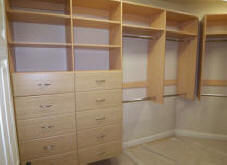
So my other psychic bid involved a query from a local closet outfitter – he’s a one man show who installs closet shelving similar to the big national companies you are probably familiar with. Two of his brothers own a commercial cabinet shop and had been providing all the shelving, but they had sold their shop and he needed to find a new supplier. Now I’m no stranger to melamine, and frankly, the idea of volunteering to handle a mountain of the stuff every year does not appeal to me, but something else did. I figured if I could outsource most of the cutting and edgebanding, I could use the ShopBot for all the machining. If I could create a system to process the closet parts that almost anyone could follow, then I could get almost anyone to do the actual work. In a nutshell, it has almost turned out that way.
I had done a small job using RTA (ready-to-assemble) fittings – the ones that come with all that flat-packed “furniture” where the end-user assembles it themselves with a screwdriver – and I know that the big closet companies use them routinely. My prospective customer was screwing all his parts together – even though his brothers’ commercial casework shop had a high-dollar CNC machine, they couldn’t be bothered to program each of his jobs so they were just providing him with generic line-bored parts – holes all the way up and he could use whichever ones he wanted on each panel. I told him I could do at least as well to start with and eventually work out a way to custom machine each panel for the RTA fittings, shelves and hardware.
The closet program was one of the driving reasons behind building my vacuum table and adding the air drill, both of which I completed last summer just as we were finalizing our first few orders. Once the ShopBot was ready, I spent close to 40 hours writing a bunch of part files that would process each of the pieces needed to build a closet – side panels, shelves, rails and drawers. I started with what was needed for the first few jobs, then added options and features as they were required. It turned out not to be too hard to implement the RTA fittings pretty early in the process. It’s now six months later, and it has grown into what I would call a suite of files including “master” files that allow the operator to choose which type of part to machine and enter all the pertinent information.
So what I do is buy bundles of melamine (a bundle is around 40 sheets) and have it ripped to our standard sizes and edgebanded. Now if I were back in the old shop with multiple employees and a nice panel saw I could easily rip and band these parts in-house and save some money, but with just me and a helper and my 10” tablesaw usually covered up with regular cabinet work, that’s just not an option. So I ended up renting a storage space down the street and filling it up with 4”, 12” and 16” rips of edgebanded melamine, plus drawer material and some hardware. We go grab whatever we’ll need for the next few jobs and start machining. For side panels we put the full 8’ rips on the ShopBot, where they get cut to length and drilled on one side, then flipped over and drilled on the other side. For shelves and rails, we cut the edgebanded rips to length on the tablesaw, then use the ShopBot to machine the ends for the RTA fittings. I know we could be machining these parts out of full sheets and just edgebanding them, and I may move in that direction someday, but for now this system works well, mainly because there’s no programming required for each job (and it’s easier on my poor old edgebander).
It’s a pretty simple system that can be used by any reasonably intelligent person to fill a closet order without my having to do much of anything. It’s not exactly at the point where it runs itself; I’m still spending several hours a week tweaking the files, overseeing the production, training operators, etc., but we are consistently producing well-fitting parts, and the sales, design and installation are all handled by someone else. I certainly can’t say the whole program has been free of problems (in fact I’m saving up a few of the problems for a future installment) but it has become a nice little part of my business. As a side benefit, it has caused me to evaluate how I process parts through the shop, and I’ve been able to streamline my regular cabinet production by using some of the techniques I developed for the closet jobs.
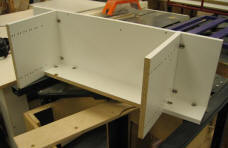 One of the test assemblies during the initial R&D stage. We soon switched from the zinc fittings to white plastic, which are less expensive and seem to work better. |
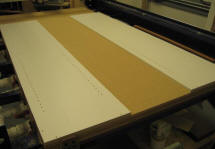 Each side panel is placed on one half of the table where it gets cut to length and drilled on one side, then flipped over onto the other half of the table to be drilled on the other side. The operator starts at one end of a wall, enters the critical dimensions and a code corresponding to what type of drilling pattern is needed, and the machine drills all the appropriate holes for one section of closet. |
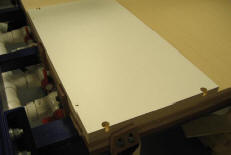 Shelves are placed on one end of the table to have one end machined, then slid to the other end of the table to have their other end machined. It seems a little labor intensive, but it goes quickly and there is no need for programming or other compensation for the length of the part – all shelves get machined the same way regardless of length. |
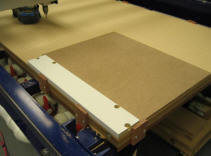 For the rails we use a mask to block the airflow through the open area of the vacuum zone. |
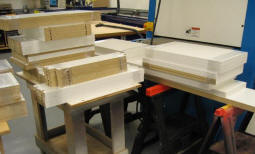 |
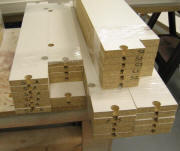 |
| Orders come in via e-mailed PDF plans and elevations, and stacks of finished parts are picked up by the client. I never have to leave the shop. | |
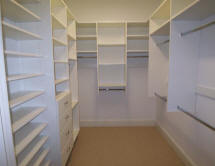 |
 |
| I’m told the finished jobs look pretty good, although I’ve only seen one or two in person. |